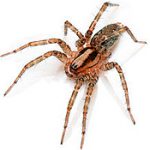The coloring of an adult T. domestica is typically dark orange to beige, with a common characteristic of striped legs and two black stripes on the cephalothorax. The abdomen is gray. In North American species, however, these colors might change for darker, almost indiscernible shades of brown. This is probably due to an adaptation of spider mimetism, set to copy the colors of T. agrestis (hobo spider) species, which the domestic house spider competes with over certain regions.
They are active and agile hunters, relying on both their vision and movement speed instead of web mechanisms. Their eye configuration, with six out of eight sighting forward, allows them to distinguish even the smallest movement in front of them and either follow it, or retreat, if the movement is too considerable. These spiders are also known to be photosensitive, i.e. moving to or fleeing from the light, depending on situations.
Like many agelenids, these spiders are very precise on their movements. Instead of following a continuous gait pattern, they usually move in short intervals, stopping several times before deciding where to head next. Males will wander aimlessly around the house if undisturbed, but will soon switch to the running interval if prey or threat are spotted. Their legs are perfectly fit for walking (with tarsi bent outward on the tips) and spiders can run over quite long distances in both situations.
On several occasions, however, they also build a web. It usually consists of a multitude of stressed silk threads spun over a flat surface (such as a windowsill) near any corner, with a funnel-like structure reaching for the corner, in which the spider would typically reside (hence the name). These webs can become quite large if undisturbed. They act like cord strings, helping the spider glide over them, and once a prey stumbles into the web, it will quickly get attacked, then dragged inside the funnel part and eaten, but very rarely stored underneath the structure.
Females that dwell indoors would usually live for over one or two years on the same web, with some residing for as long as seven years in rarely disturbed places (attics, basement or cellar parts, storage rooms, etc.). Outdoor females perish with cold weather and males rarely live for over a year. In late Fall, an egg sac is made containing up to 50 eggs and put in the very tip of the funnel, protected by the female. The spiderlings will hatch in early to mid April and go over seven molts to reach adulthood.
T. domestica bears a behavior toward large intruders that may be perceived aggressive. As long as its web is undisturbed, the spider will retreat to the funnel tip and stop responding to any movement whatsoever. If the web is attacked and partially destroyed, the spider will run toward the intruder and try to confuse it with irregular movements (randomly running around it, for example). If the threat is fast enough to follow them, the spider will then walk on cast objects, including protruded body parts, in hopes of reaching soft tissue to inflict a bite. Because of its speed, it can cross even the most slippery surfaces and softened clothes rapidly. The greatest danger will be represented by T. domestica if it gets stuck between clothes and skin, both consecutively and accidentally (while occupying a sleeve of one’s shirt, for example).
Domestic house spiders deliver venomous bites on almost all occasions. Their venom is both neuro- and necrotoxic and can leave small lesions over the bitten area, similar to that of a burn. Besides causing considerable local pain, venom effects are minimal in healthy adults and may sometimes include malaise and fatigue feelings in children and elderly, but will usually wear off on the same day. The bite area is better treated with iodine and will disappear within the next three days. No medical attention is required.
Surprisingly enough, these spiders can be very docile if recently fed, as often tend to overeat and digest the processed food. When doing so, they can easily be manipulated and even taken away from their webs and grabbed, without much aggressive behavior. On the contrary, females protecting their eggs can also appear to be slow moving and docile, but will not hesitate to defend their young. At any situations, it is recommended to handle the spider with care and make sure it has first been dealt with when removing its web.

